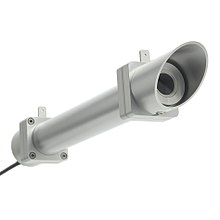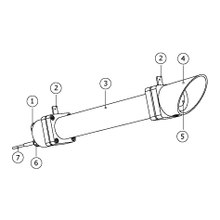Pyrheliometer
Pyrheliometers (from Greek pyros = "fire" and helios = "sun", literally: sun fire measuring device ) belong to the meteorological radiation measuring devices ( pyrometry = radiation measurement). They measure the direct irradiance (in watts per square meter) from the direction of the sun . In the past they were also known as pyroheliometers .
functionality
The radiation is absorbed by a black thermopile or thermometer (for example a black colored metal strip) or a black hollow body of known heat capacity . The incident radiation leads to heating, from which the radiation flux can be calculated. Depending on the type of wind-protecting cover, only the short-wave radiation component (quartz glass) or the entire radiation (plastic) can be measured. Measuring devices that measure the total irradiance , so-called pyranometers , work without shielding the indirect irradiation and are useful for measuring the power of solar energy systems.
Measurement principles
Three different measuring principles are used:
- Phase transition
- The heat output of the irradiated body is used to bring about a phase change (melting, evaporating) of a substance that is thermally connected to the body.
- Comparison of temperatures
- The illuminated thermopile is compared with a second thermopile or thermometer, which is not exposed to solar radiation and is kept at air temperature. The temperature difference proportional to the radiation is z. B. measured with a thermocouple.
- Comparison of the heating power
- The electrical heating power required to bring an unirradiated reference block to the same temperature as the exposed thermopile is measured. The operating current is converted into the measured variable.
Designs
The following designs exist:
- Abbot waterflow pyrheliometer (measuring principle 1)
- Waterstirpyrheliometer according to Abbot (measuring principle 1)
- Ice pyrheliometer according to Volochine (measuring principle 1)
- Silverdiskpyrheliometer according to Abbot (with calibration) (measuring principle 1)
- Compensation pyrheliometer according to Angstrom (measuring principle 3)
- Marvin pyrheliometer (measuring principle 1 & 3)
See also: pyranometer , pyrometer , radiometer , actinometer
literature
- Andreas Ibrom: Radiation measurement . Institute for Bioclimatology at the Georg-August-Universität Göttingen (physics internship script), accessed on March 25, 2014.
- The Brockhaus - Weather and Climate , FA Brockhaus GmbH, Leipzig and Mannheim 2009.
Footnotes
- ↑ Johannes Wilsing , Julius Scheiner : Determination of the temperature of 109 brighter stars from spectrophotometric observations . In: Astronomische Nachrichten, Vol. 183 (1909), Issue 7, Article No. 4375, pp. 97-108.

